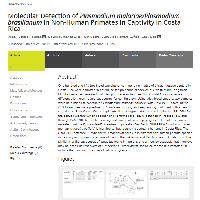Resumen
- One hundred and fifty-two blood samples of non-human primates of thirteen rescue centers in Costa Rica were analyzed to determine the presence of species of Plasmodium using thick blood smears, semi-nested multiplex polymerase chain reaction (SnM-PCR) for species differentiation, cloning and sequencing for confirmation. Using thick blood smears, two samples were determined to contain the Plasmodium malariae parasite, with SnM-PCR, a total of five (3.3%) samples were positive to P. malariae, cloning and sequencing confirmed both smear samples as P. malariae. One sample amplified a larger and conserved region of 18S rDNA for the genus Plasmodium and sequencing confirmed the results obtained microscopically and through SnM-PCR tests. Sequencing and construction of a phylogenetic tree of this sample revealed that the P. malariae/P. brasilianum parasite (GenBank KU999995) found in a howler monkey (Alouatta palliata) is identical to that recently reported in humans in Costa Rica. The SnM-PCR detected P. malariae/P. brasilianum parasite in different non-human primate species in captivity and in various regions of the southern Atlantic and Pacific coast of Costa Rica. The similarity of the sequences of parasites found in humans and a monkey suggests that monkeys may be acting as reservoirs of P.malariae/P. brasilianum, for which reason it is important, to include them in control and eradication programs.
